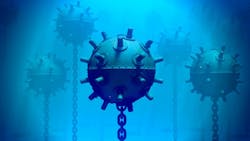Navy asks industry for stealthy ways to neutralize underwater sea mines without tipping-off the enemy
ARLINGTON, Va. – U.S. Navy researchers are asking industry for enabling technologies to neutralize low-observable underwater explosives from over-the-horizon ranges and undetected by enemy forces.
Officials of the Office of Naval Research in Arlington, Va., issued an updated solicitation (N00014-20-S-B003) on Friday for the Low Observable / No Collateral Damage Neutralization of Underwater Mines and Waterborne Improvised Explosive Devices project.
Researchers want enabling technologies to destroy or disable underwater mines or waterborne improvised explosive devices (IEDs) without causing explosions or other effects that an enemy nearby could detect and give away the presence of stealthy special forces.
Related: Navy ramps-up production of airborne counter-mine systems to neutralize hidden ocean mines
The idea is to use divers or unmanned underwater vehicles (UUVs) quietly to rid combat areas of mines and IEDs that could hinder and disrupt expeditionary forces like Navy SEALs or other Special Forces.
Researchers want diver- or UUV-delivered payloads to neutralize underwater mines and IEDs without causing explosions that could give away the element of surprise, or cause damage to underwater infrastructure.
Mine-neutralizing payloads should be controllable from extended ranges. These payloads not only will neutralize mines and IEDs, but also enable bomb-disposal experts to inspect the explosive to determine the location of batteries, fuzes, and other crucial components. Payloads should be able to communicate with UUVs at over-the-horizon ranges.
Related: Navy moves to low-rate initial production of minehunting unmanned surface vessel
Researchers are particularly interested in three technical areas: low observable and no collateral damage neutralization; diagnostic sensors; and cyber-secure high bandwidth communications and standoff command and control for undersea robots.
Navy experts say they plan to spend about $19 million over two years among three or four contractors. Companies interested should upload proposals no later than 14 Oct. 2020 to the FedConnect Website at https://www.fedconnect.net/FedConnect/default.htm.
Email technical questions to the Navy's Brian Almquist at [email protected]. More information is online at https://beta.sam.gov/opp/773c635d6daf4ea5a9169c2f0b8191cf/view.
About the Author
John Keller
Editor-in-Chief
John Keller is the Editor-in-Chief, Military & Aerospace Electronics Magazine--provides extensive coverage and analysis of enabling electronics and optoelectronic technologies in military, space and commercial aviation applications. John has been a member of the Military & Aerospace Electronics staff since 1989 and chief editor since 1995.
